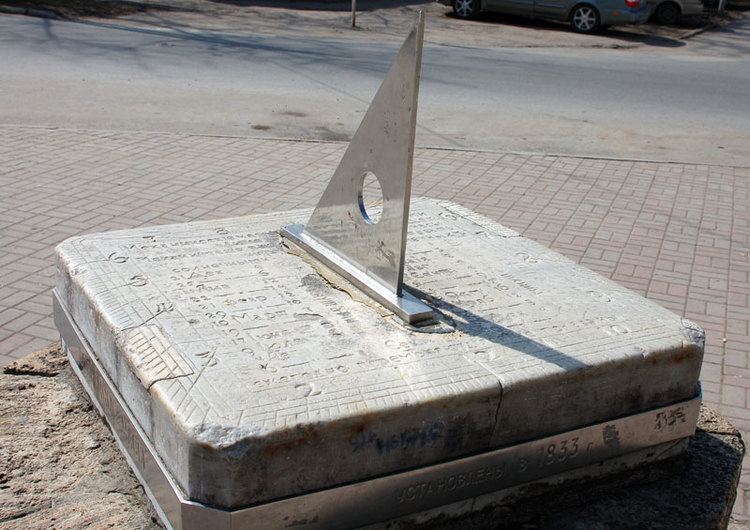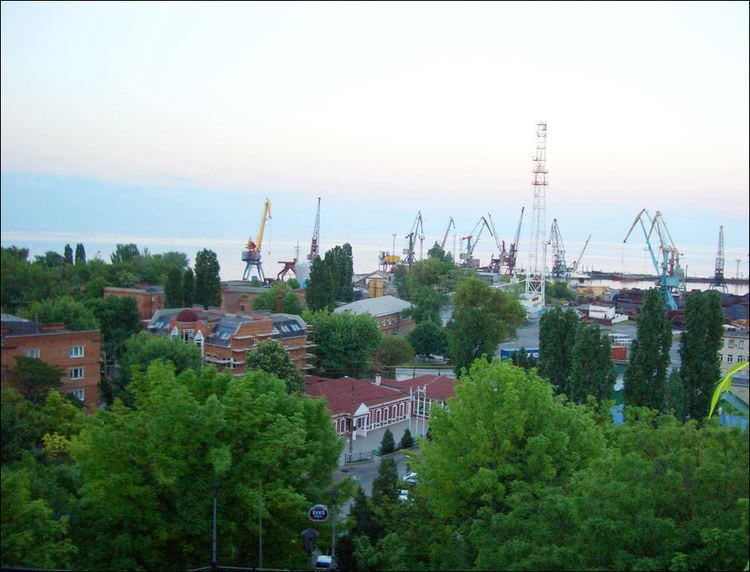Population 257,681 (2010) Founded September 12, 1698 | Area 80 km² Mayor Vladimir Prasolov | |
 | ||
University Taganrog State University of Radioengineering | ||
Map of Taganrog
Taganrog (Russian: Таганрог; [təɡɐnˈrok]) is a port city in Rostov Oblast, Russia, located on the north shore of the Taganrog Bay in the Sea of Azov, several kilometers west of the mouth of the Don River. As of the 2010 Census, its population was 257,681.
Contents
- Map of Taganrog
- 20140116 rapid dvorkovich mem taganrog
- Gimbarr taganrog version 1 0
- History of Taganrog
- Administrative and municipal status
- Climate
- Economy
- Military
- Higher education
- Taganrog in literature
- Notable people
- Twin towns and sister cities
- Klokov dinner after training day 21 06 2013
- References

20140116 rapid dvorkovich mem taganrog
Gimbarr taganrog version 1 0
History of Taganrog

The history of the city goes back to late Bronze Age–early Iron Age (between the 20th and 10th centuries BCE), when it was the earliest Greek settlement in the northwestern Black Sea Region, and was mentioned by the Greek historian Herodotus as Emporion Kremnoi. Taganrog was officially founded by Peter the Great on September 12, 1698. The first Russian Navy base, it hosted the Azov Flotilla of Catherine the Great (1770–1783), which subsequently became the Russian Black Sea Fleet. Taganrog was granted city status in 1775.
By the end of the 18th century, Taganrog had lost its importance as a military base after Crimea and the entire Sea of Azov were absorbed into the Russian Empire. In 1802, Tsar Alexander I granted the city special status, which lasted until 1887. In 1825, the Alexander I Palace in Taganrog was used as the Tsar's summer residence, where he died in November 1825. Taganrog became an important as a commercial port, used for the import and export of grain by the end of the 19th century until the early 20th century. Industrialization increased in the city when Belgian and German investors founded a boiler factory, an iron and steel foundry, a leather factory and an oil press factory. By 1911, fifteen foreign consulates had opened in the city.
During World War I, Taganrog was occupied by the troops of the German Army from May 1918 until August. In 1919, General Anton Denikin established his headquarters at the Avgerino mansion in the city while commanding White Russian troops fighting in South Russia during the Russian Civil War. When the White Russians were defeated and Bolshevik power was established in the city on December 25, 1919, Denikin's remaining troops and the British Consulate were evacuated by HMS Montrose. Full power was granted to the Executive Committee of The City Soviet Workers' council on December 17, 1920, and Taganrog briefly joined the Ukrainian SSR as the administrative center of Taganrog Okrug, until it was transferred to the Russian SFSR along with Shakhty Okrug on October 1, 1924. During World War II, Taganrog was occupied by Nazi Germany from 1941 to 1943 during Operation Barbarossa, when two SS divisions entered the city on October 17, 1941, followed by Wehrmacht divisions, with the city suffering extensive damage. The occuption led to the local government system being replaced by German-style Bürgermeisteramt (English: Mayor's Office), which governed the city until it was liberated by the Red Army on August 30, 1943.
Administrative and municipal status
Within the framework of administrative divisions, it is incorporated as Taganrog Urban Okrug—an administrative unit with the status equal to that of the districts. As a municipal division, this administrative unit also has urban okrug status.
Climate
The climate of Taganrog is temperate (Köppen climate classification Dfa). Taganrog experiences moderately cold (mild by Russian standards) winters and hot summers.
Economy
Taganrog is the leading industrial center of Rostov Oblast. Local industry is presented by aerospace, machine-building, automobile, military, iron and steel industry, engineering, metal traders and processors, timber, woodwork, pulp and paper, food, light, chemical and industry of construction materials, and one of the major ports of the Sea of Azov.
The biggest company currently operating in Taganrog is Taganrog Metallurgical Plant (publicly traded company Tagmet) which manufactures steel, steel pipe for oil and gas industry and consumer goods. The other major employer is Taganrog Auto Factory (TagAZ Ltd.) which originated from Taganrog Combine Harvester Factory. The plant manufactures automobiles licensed by Hyundai. The production line includes Hyundai Accent compact sedan, mid-size Hyundai Sonata, sport utility vehicle Santa Fe and Hyundai Porter pickup truck.
Taganrog is also home to the aircraft design bureau Beriev.
The area around Taganrog has a large industrial potential, a diversified agricultural industry, production plants and a modern infrastructure. The location of Taganrog on the intersection of traffic routes and the seaport facilitate access to the emerging CIS markets.
Taganrog's main trading partners are the CIS countries, South Korea, Turkey, Italy, Greece, and Egypt.
Military
An airbase is located 3.6 miles (5.8 km) to the northwest of the city.
Higher education
Taganrog in literature
The image of the city and its people is featured in numerous Anton Chekhov works, including Ionych, The House with an Attic, The Man in a Shell, Van'ka, Three Years, Mask, My Life and more. It is believed that Taganrog image may be used as Lukomorye (fairy tale land) in Alexander Pushkin's Ruslan and Lyudmila (1820). It also appeared in the novels of Ivan Vasilenko, Konstantin Paustovsky and in the poems of Nikolay Sherbina and Valentin Parnakh.
The conspiratorial legend of "Elder Fyodor Kuzmich" is cited in the book Roza Mira by Russian mystic Daniil Andreyev. According to this legend, the Russian tsar Alexander I did not die in Taganrog, but instead left his crown and the status of monarch to continue his life as a traveling hermit.
In foreign literature, the city was mentioned in the titles of the following novels: Der Tote von Taganrog by Eberhard von Cranach-Sichart, Taganrog (dedicated to death or disappearance of Alexander I) by Reinhold Schneider.
In 2004 Irish poet of German heritage Sabine Wichert published a collection of poems titled Taganrog.
Notable people
Numerous Russian and international aristocrats, politicians, artists, and scientists were born and/or have lived in Taganrog. Taganrog is the native city of Anton Chekhov, Faina Ranevskaya, Sophia Parnok, Alexandre Koyré, Isaac Yakovlevich Pavlovsky, and Dmitri Sinodi-Popov; names of Russian emperors Peter I of Russia and Alexander I of Russia; Cornelius Cruys, Giuseppe Garibaldi, Pyotr Tchaikovsky, Adolph Brodsky, Konstantin Paustovsky, Nestor Kukolnik, Achilles Alferaki, Ioannis Varvakis, Sergei Bondarchuk, William Frederick Yeames and many other famous people are brought to mind when Taganrog is mentioned.
Twin towns and sister cities
Taganrog is twinned with:
